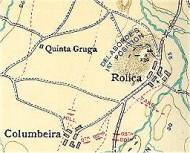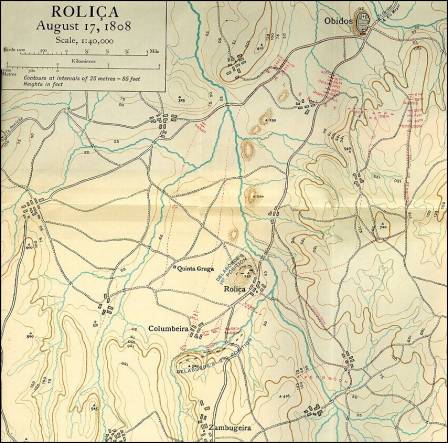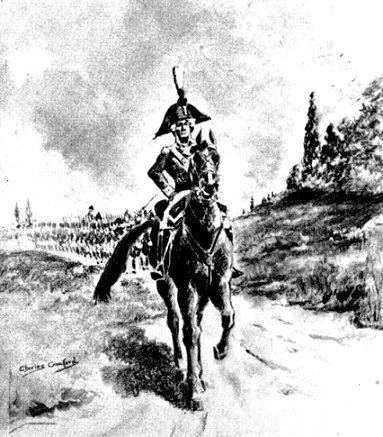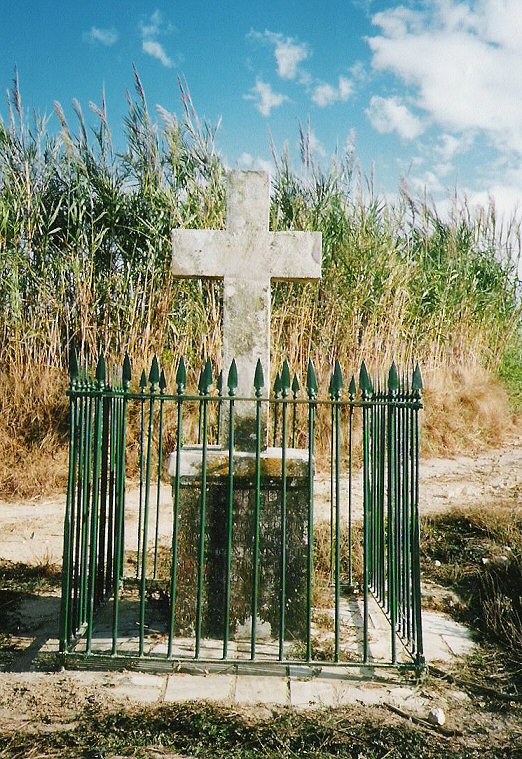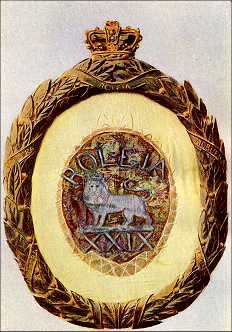Rolica (1808)
The Battle of Rolica, 17th August 1808, was the first major action of the British Peninsular War, and the 29th Foot played a major role as part of 3rd Brigade commanded by General Nightingale. At the time the 29th Foot was commanded by Colonel George Lake, interesting character.
In June 1808, the British government received word of the Spanish uprising against the French. The British had a tradition of supporting the Portuguese and used the Spanish insurrection as an excuse to send an expeditionary force to Portugal. Their mission was to expel the French Army, under the command of General Junot, from Portugal. The initial British force would be under the command of a young general who had made his reputation in India: Sir Arthur Wellesley (later became Lord Viscount Wellington). The French commander in Portugal, General Jean-Androche Junot, received word of the British landing and sent General Henri-François Delaborde to observe ". . . Delaborde advanced to Alcobaça, but could not find a suitable defensive position. He withdrew to Roliça, where he placed his force on a low hill just west of the town. About 2 kilometers to his rear was a ridgeline that ran east-west. There he waited for the British. |
Lieut.-Colonel Lake |
The state of Wellesley’s combined army was poor, and makes their subsequent success even more amazing.
Wellesley’s own corps of 9,000 men had been in Ireland, awaiting an expedition against South America in retribution for Whitelock’s scandalous failure the year before at Buenos Aires. This force was almost entirely of infantry, with only 380 men of the 20th Light Dragoons and artillery consisting of five 9 pounders, ten 6 pounders, and three mortars. The troopships could only carry a total of 180 horses, though, making most of the cavalry and artillery impotent.
|
The next force to join them was the corps under General Sir Brent Spencer, which came up from Cadiz and consisted of about 4,000 men, with no cavalry and only four 6 pounder guns and two mortars. These men had spent most of their time since the previous December floating around in transport ships, spending little time ashore and none in action. Their physical fitness, after so long confined, could have been rather shaky for marching and fighting in such a mountainous country. The fitness of the army for battle could also be questioned. Although well trained, most of the men in the combined army would be inexperienced, the 29th Foot for example had not seen action for nine years, and few in the ranks then would still be serving. Besides these setbacks, Wellesley also had very limited cavalry and artillery (both arms which he had learnt the importance of in India), and even more limited means to move them. Compared with Junot’s veteran French army, the British must have made a pretty poor showing. |
The last part of Wellesley’s army was the Portuguese contingent. Wellesley had negotiated and begged with the Bishop of Oporto, at that time the head of the remaining government and armed forces in Portugal, for men, but had received only 1,700 men, of whom 270 were badly needed cavalry. If Wellesley’s British troops would look bad to the French, the Portuguese looked bad even to the British. Lieutenant Leslie, of the 29th, describes his allies as having “little or no uniform, but merely in white jackets, large broad-brimmed hats turned up at one side, some having feathers, and others none, so that they cut rather a grotesque appearance.” A far cry from the ‘fighting cocks’ of later years, even General Spencer referred to them as “’ragamuffins’”.
It took more than a week for Wellesley to organise this force and prepare it for movement. Horses had to be borrowed from the Portuguese to mount as many cavalry as possible and make the artillery mobile. Wellesley also had to form a commissariat, none having been provided by Horse Guards. He had managed to requisition two companies of the Irish Corps of Wagoners, albeit minus their wagons and any other equipment, but this was hardly equal to the job of supplying a force of 15,000 men, soon to be doubled by the redirection of Sir John Moore’s Swedish expedition and a further scrapping of troops currently on garrison duties.
What Wellesley had learnt in India, but apparently the Horse Guards had not yet, was that “if I had rice and bullocks I had men, and if I had men I knew I could beat the enemy.” Or, as Napoleon would later put it, ‘an army marches on its’ stomach.’ After campaigning across the vast and arid plains of India, Wellesley was well aware of the difficulties and absolute necessity in procuring adequate supplies for his men before even starting a campaign. A huge amount of his time and correspondence in India was devoted to this subject, and now in Europe he was having to go through the same motions.
Lengthy discussions with the Bishop of Oporto, and bargaining with the locals, provided an enough horses to equip the artillery that he had brought with him from Cork, and another sixty cavalrymen. The rest of the cavalry had to stay behind, though, as did Spencer’s artillery. He also managed to gather together 500 mules and 300 bullock carts to carry the food, ammunition and supplies he would need to evict the French from Portugal.
The French
At the time that Wellesley landed, the French were well spread out. Marshal Junot, overall commander in Portugal, had about 25,000 men at his disposal. (Unfortunately, all figures for the French Army are approximate and open to debate, but the figures given will be those most widely excepted.) Of these, there were (approximately): 6,500 in Lisbon as a garrison; 3,500 in various other garrisons such as Almeida and Elvas; 5,000 with Delaborde at Alcobaca (40 or so miles south of Mondego Bay); 6,500 with Loison at Santarem (about 25 miles south-east of Delaborde); while Junot himself had a disposable force of about 3,000 men ready to move north from Lisbon.
Their plan was for Loison and Delaborde to hold the line across the top of the Lisbon peninsula, blocking Wellesley’s advance. When Wellesley was to hit either force, the other would move in on the flank, while Junot would hopefully then arrive with reinforcements from Lisbon.
Wellesley, though, managed to preempt this plan by moving against the closest French force, Delaborde’s, in the second week of August. Delaborde’s force consisted of the:
70th of the Line (2 Battalions)
2nd Leger (1 Battalion)
4th Leger (1 Battalion)
4th Swiss (1 Battalion)
26th Chasseurs
The exact number of men in this force is a matter of great debate, with estimates ranging from 1,900 (Thiebault) to 6,000 (Wellesley), but there was probably around 5,000 (Oman). Whatever their exact strengths, Delaborde was outnumbered and Loison still some distance away. When pressed by Wellesley around Alcobaca, he fell back to more favourable ground around the village of Rolica.
Rolica sat in a basin, surrounded by a horse-shoe of steep ridges open to the north. In the middle, by the village, was a smaller hill with a wind mill, while behind it (to the south) under the slope of the ridge were the villages of Columbeira (by which the battle is sometimes known) to the right, and Zambugeira to the left. The road to Lisbon ran down the middle of the basin and up over the far ridge between the two villages. Delaborde drew up his forces sitting on the small hill in the middle, blocking this road.
Wellesley’s Advance
The Wellesley we see advancing on Rolica is a surprisingly cautious one. In India, fighting always against the odds, Wellesley had shown something of a name for daring and decisive action, seldom maneuvering to any extent at a tactical level. At Rolica, though, he split his forces into three separate columns across his front:
1. On his left were: General Ferguson with:
Ferguson’s Brigade: 36th, 1/40th, 1/71st
Bowes’ Brigade: 1/6th, 1/32nd
6 guns
2. In the centre were:
Fane’s Brigade: 5/60th, 2/95th (on the left)
Nightingale’s Brigade: 29th, 82nd (in the centre)
Hill’s Brigade: 5th , 9th, 38th (on the right)
Caitlin Craufurd’s Brigade: 45th, 50th, 91st (in reserve)
Portuguese: 6th Cacadores (in reserve), 6th & 12th Cavalry
20th Light Dragoons
12 guns
3. On the left were: Colonel Trant with:
Portuguese: 12th, 21st & 24th Infantry Regiments, 11th Cavalry Regiment (only 50 men strong)
With these columns he begins a very tentative outflanking manoeuvre, sending Trant’s Portuguese around to the left of the hill and Ferguson’s force to the right to envelope the French from both sides, while the rest of his forces made a diversionary demonstration to the front. Wellesley’s aims were to surround and defeat Delaborde, preferably before he could join with Loison or any men sent from Lisbon, to prevent the French from showing an immediate united front against the British and allow the reinforcements sailing from Britain a safe beach-head to land at.
However, his way of going abut it is not a typically Wellesley way of acting at all, and it is interesting to question why he acts this way.
For one thing, Wellesley had a good idea of the strengths and dispositions of the enemy, laying them out in quite accurate terms in a dispatch to Lord Castlereagh on the day before the battle. This is a lot more than he often knew in India, and this was the first time in any battle that he had significantly out-numbered the enemy. Yet an totally alien caution overtakes him. At Assaye (Sept. 1803), although terribly out-numbered and with a river to cross, he had charged in regardless; at Malavelly (March 1799), he had marched staunchly up hill into the face of the enemy and traded them shot for shot against the odds; similarly at Arguam (Nov. 1803) he had marched straight in and hit the centre of the enemy line; and at Manauli (July 1800) he had personally led an unsupported cavalry charge against his foe’s encampment. Likewise, anyone who has looked at Wellesley’s sieges in India feels no surprise at all at Badajoz or Cuidad Rodrigo. At Damal (June 1800), Arrakhera (January 1802), Ahmednager (August 1803) and most impressively at Gawilgarh (December 1803) - a never before taken mountain stronghold - he had simply dashed his men against the walls with the minimum of preparation. And each time it had worked.
Sir Arthur Wellesley, then, was neither the cautious, defencive nor inexperienced general he is often made out to be in 1808. He knew his business well, and had achieved staggering feats against Indian armies drilled and armed in European methods and of an exceptionally high calibre and large numbers. Yet faced with a tiny French force on an isolated battlefield in Portugal, he begins a lengthy and unnecessary process of manoeuvre which only allows the French to slip away to a much tougher position.
Delaborde, having enticed Wellesley into spreading his army out and setting his attack into motion, pulled his men back to a position on the ridge behind Columbeira. It is an elementary mistake for Wellesley. He knew that Loison was in the area, and that he would attempt to unite with Delaborde, yet he wastes time in pointless manoeuvre, and then allows Delaborde to buy himself even more time by withdrawing back into another, almost unassailable position.
Had Wellesley had a crisis of confidence? Although he professed that “I am not afraid of them [the French], as everyone else seems to be” before leaving for Portugal, he did admit that considering the enemy that had overwhelmed Europe was “enough to make one thoughtful.” This is probably as close to an admission to fear as Wellesley could make, after all, one must wonder what general would admit to fearing the enemy if he wanted to keep the confidence and trust of his men. But he was probably, quite naturally, nervous of his first engagement with the French as the commander of an army. He does seem to have given long and hard thought to the French and their “new system of strategy”, and came to the conclusion that “my die is cast, they may overwhelm me, but I don’t think they will out-manoeuvre me.”
It is quite possible that, facing an unfamiliar enemy whose army had captured the whole of mainland Europe with a tiny army with little experience, cavalry or artillery and dubious support from his allies, Wellesley’s confidence had cracked, and quite understandably at that. And so, true to his statement of intent, Wellesley could have tried to play the French at their own game, trying to out manoeuvre his opponent rather than use his own tried and tested methods. Ironically, his own tactics probably would have caught Delaborde on the hop, either over-running him on his position on the hill or, more likely, as his army tried to fall back, as happened at the end of the battle. But instead, the lengthy manoeuvring and displays in front of the French gave them the time and warning they needed to draw Wellesley in and then retreat to the positions that they had prepared on the ridge.
It is a mistake that influences Wellesley for years to come. At Vimeiro, only a week later, he sits on the defencive and lets the French come to him; at Oporto in May of the next year we see his old flair and directness as he crosses an ‘uncrossable’ river in the face of the enemy to rout them from a truly formidable position; and at Talavera a few months later we see firstly his impatience with Cuesta for not immediately attacking the single French army before it is reinforced (having learnt what tarrying in such a situation can lead to at Rolica) and then again fighting a defencive battle, and letting the enemy come to him. Of course, at Vimeiro and Talavera he uses the ‘reverse slope’ tactic that has, quite wrongly, become the image of Wellesley in the Peninsula. It was not a tactic he used widely and certainly not one that he invented. The first person to use this tactic in an Anglo-French battle, was Delaborde.
Wellesey's Second Advance
The first advance of the British had been something of an anti-climax. The 95th and the 60th had got caught up in a “sharp contest” on the left of the centre column, but had managed to push back the French skirmishers on this flank although many Riflemen like Harris had fired all of their ammunition. By now the day was hotting up. Lieutenant Leach of the 95th recalled the “intense and suffocating heat ... every mouthful of air was such as is inhaled when looking into an oven.”
The French, having achieved their object of delaying the British and careful not to leave their own departure too late, had fallen back in good order from the hill onto the ridge. The ridge around Rolica is big and steep - about 300 feet high with a gradient of one in ten. Up it run four steep gullies - what Wellesley rather misleadingly calls ‘passes’ - scarcely easier to climb. They were so narrow that “only two or three men could get up at a time”, and these were “obliged at times to climb on hands and feet”. These would prove greatly prohibitive, particularly as each man still carried his full pack and greatcoat, the 29th only stopping to take theirs’ off half-way up the hill. One officer of the 45th wrote to his parents that “our Regiment was so entirely done up, that scarcely a man could stand when we got to the top of the precipice, some places of which only two men could get up at a time.” In the centre, Wellesley began to regroup his infantry into four columns, one for each gully. On the left were the 45th, 5/60th and the 95th, in the next gully were the 82nd, in the next the 29th supported by the 9th, and on the right the Light Companies of the 9th, 29th and 82nd, supported by the 5th. These columns were to make demonstrations against the bottom of the passes to distract and pin down the French to the front of the ridge while Ferguson and Trent went around the back. |
|
Colonel George Lake (29th Foot)
This was a sound enough plan, and unlike the previous advance, a plan that made sense in the circumstances. To make up lost time the new formation was to be formed on the march. As each battalion advanced, so it moved into place. Unfortunately, because of the angle of advance and the fact that there were several streams to cross and villages to pass, one of the lead battalions, the 29th, became isolated in front of the rest of the advance. Out in front, they came under fire from the French on the ridge and began suffering casualties as they moved along the length of the ridge in front of the French towards their allotted gully. The 29th was commanded by Lake, another old India hand with a reputation for daring and frontal assaults. Today would be his first European battle, too, and he rode in style in full dress on a charger 17 hands high to mark the occasion.
Lieutenant-Colonel Lake leading the 29th Foot |
The unfortunate part was that Lake was by far the wrong type of man to put at the front of a diversionary attack. His personality was that of a dashing and daring leader, and all that saw him that day agree that he had mind only to win glory for himself and his Regiment. Almost inevitably, when they reached the foot of their gully (the only regiment to be in position at this point) he turned his Regiment up it and kept going. For the first half of the climb the French fire was light, effectively blocked by the sides of the gully. About half-way up, in an olive grove, the Regiment (minus it’s Light Company) stopped and stripped off it’s packs and excess equipment. Ready now for action, Lake led forward the five companies of the right wing of the Regiment. This came under only sporadic fire to start with, as they were facing at the top the red-coated 4th Swiss, who initially mistook the British for more of their own men retreating. Even when their mistake was realised, the Swiss showed a reluctance to fight, although fire began to pour down from the French regiments on either side. Lake, conspicuous still mounted on his horse, made an obvious target, and his horse was soon shot, but he mounted himself again on his spare, which had been ridden by Major Way. In front of the British now was a low wall, behind which the French were waiting. Lake stopped now, waiting himself for the other four companies of his Regiment to arrive. Even as the French behind the wall began a galling fire, he still waited, crying “Don’t fire men; don’t fire; wait a little, we shall soon charge, the bayonet is the true weapon for a British soldier.” Taking heavy casualties now the 29th faltered, and Lake galloped behind the line to straighten it, but fell before he reached the end, first wounded in the neck and then shot through the body by a French marksman. |
As Lake fell, confusion broke out. The Regiment was leaderless, and taking heavy casualties, when a mass of Swiss started forward from the right calling out that they were surrendering, making their way down to the British and even began shaking hands. (The Swiss showed a tendency to desert from the French Army in Portugal - several hundred finally deserted, many joining the 5/60th) At the same time, from the right rear, a battalion of French, perhaps fearful of being cut-off on that end of the ridge or mistaking the Swiss desertion as an advance, charged the Regiment. The Regiment was in no position to resist. Major Way recalled that “out of about 70 men , principally Grenadiers, who attained the summit of the height where the enemy where strongly posted, only 20 remained at [the] time the French in considerable force charged us”. This end of the line, not properly formed to begin with, exhausted by the climb and in disarray after the Swiss ‘advance’, shattered when hit from behind. Major Way, five other officers and 25 men were captured and carried off to the French lines, and the remaining men fled back down the pass, meeting the four left flank companies of the Regiment coming the other way.
Confusion still reined. The commanding officer and all but three of the officers in the five right wing companies had been killed or captured, and the French were pouring down behind then. In the gully, “some individuals of both sides got mixed, and had personal encounters with the bayonet, [the French] however did not venture to press us, or follow us into the woody ground, where we formed on the left wing”. In the brief respite, the Regiment reformed, and received reinforcement from the 9th, who had come up in support.
Together they pressed ahead again and again, but were unable to push the French from the summit, even when the rest of the gullies were assaulted. The other columns had managed to creep up the rest of the gullies while the French were diverted by the 29th - an officer of the 45th reckoned that “the 29th completely saved us from being cut to pieces” until they neared the top. For two hours the British, outnumbered in the gullies and struggling up hill, kept up the attack. It is only, ironically, when Ferguson’s men rounded the ridge to Delaborde’s rear that the French began to retreat, and the pressure on the gullies lessened allowing the 9th and 29th to break out onto the summit.
The French RetreatWith his rear threatened, and no troops to spare now that all four gullies were being assaulted, Delaborde began an orderly withdrawal. Moving his infantry back by stages, and supported by his cavalry, he pulled his men back in an orderly fashion to a pass behind Zambugiera, about a mile to the rear. Here his men had to close up through the narrow pass and the first signs of panic appeared as the British pressed in. Pushing hard on the rearguard, the British managed to capture three of Delaborde’s six guns and a few men, but the rest of the French made it through to Cazal de Spraga where they reformed in good order. Here Wellesley, feeling his lack of cavalry, had to break off the pursuit. The Portuguese cavalry were refusing to co-operate, and he had too few of his own to have much effect. Loison, meanwhile, had been only 10-15 miles away from the battle, but with exhausted troops in no condition to march through the mountains that day to Delaborde’s aid. If Wellesley had waited another day, it is likely that Loison would have arrived, though, and he would have faced a much stronger French force. Instead, Delaborde was retreating south towards Lisbon having lsot three guns and around six hundred men, and Loison was isolated off to the east, with no chance of communication between them. To this end, Wellesley had achieved his objective, and the reinforcements which arrived over the next few days landed without resistance.
Monument to Colonel LakeThe monument to Colonel Lake at Rolica is at the head of the gully up which the 29th Foot Regiment attacked and marks either where he fell or where he was buried. The inscription reads: "To the memory of the Ho. Lieut. Col. C. A. F. Lake of the 29th Reg. who fell at the heart of his corps in driving the enemy from the heights of Columbeira on 17th Aug. 1808. This monument was erected by his brother officers as testimony of high regard and esteem." On another face is the inscription: "Restored by the officers of the 29th First Batt. Worcestershire Reg. in 1903"
|
The monument to Colonel Lake at Rolica |
Conclusion
It is ironic that the two mistakes the British made at Rolica were both made by old India hands trying to carve out a European reputation - Wellesley, showing caution when he should have tried dash, and Lake, showing dash when he should have shown caution. British casualties were lighter than the French, and a bare pin-prick compared to many later battles, but a lot of men still died. The British lost about 480 men killed, wounded or captured, most of them in Lake’s gully. The 29th lost their Colonel and another officer killed, two officers wounded, a major and seven other officer and 25 men captured and 177 men killed or wounded. The 9th lost their Colonel too, Lt.-Col. John Stuart, and 71 other officers and men killed or wounded. Ironically, even the benefits of Lake’s charge - diverting attention from the troops advancing up the other gullies leading to lighter casualties among them - are nullified by the fact that it was not the troops in the gullies who captured the ridge, but rather Ferguson’s men on the flank, as decided in the original plan. Lake’s sacrifice was pointless. But what had Wellesley gained in this ‘unnecessary’ and ‘irrelevant’ little skirmish? Well, apart from the obvious benefits to the army, like breathing space to land unopposed and the morale boost of a victory, there were also benefits to Wellesley himself. At Rolica his European reputation begins to take hold, even with the criticism that he received for the conduct of Lake. In his dispatches, Wellesley says that the 29th ‘attacked with the utmost impetuosity’ and deserve the ‘highest commendation’, and the letter he wrote to Lake’s brother-in-law is full of nothing but praise, making no mention of any mistakes and leading many to believe that he ordered the attack himself. Yet despite this, and the almost overwhelming scandal of the Convention of Cintra (in which Wellesley’s role has never been explained totally satisfactorily) the victories of Rolica and Vimeiro elevated him enough to lead to his reestablishment as commander of the British forces in Portugal in the spring of 1809. It carried him through all criticism and scandal, and from being a lesser known general and politician to a house-hold name for centuries to come. Sir Arthur Wellesley (later Lord Viscount Wellington), himself would say in later years that “Rolica was one of our most important affairs.” |
The Lion Badge |
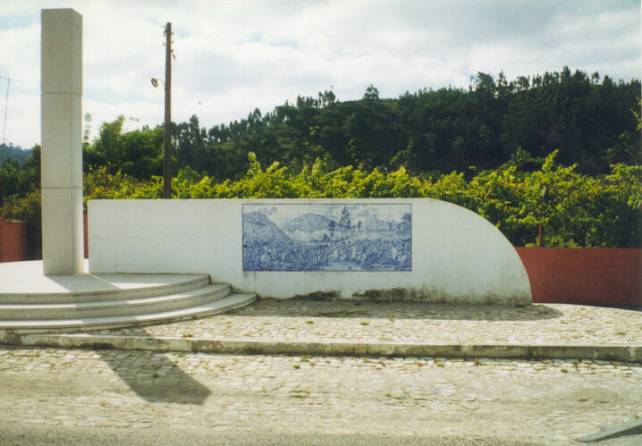
Monument commemorating the battle at Rolica (17th August 1808)


